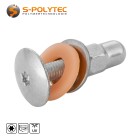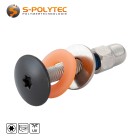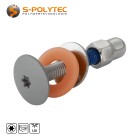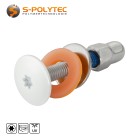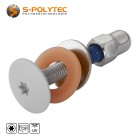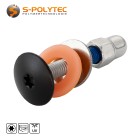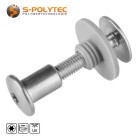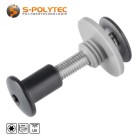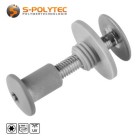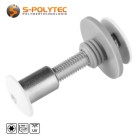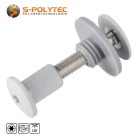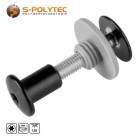
Balcony screws made of stainless steel at best prices online
For the assembly of our plastic sheets as balcony cladding or privacy protection on a metal substructure, we offe you high quality balcony screws made of stainless stell in different versions.
- Our balcony screws are available with or without a top coating.
- All of our balcony screws are made of high quality stainless steel.
- The top coating exactly matches to the color and gloss level of our HPL panels in RAL.
- Buy balcony screws in the required quantity - from just one screw.
Balcony screw-set with steel cap stainless steel (unpainted)
 from €1.00 /
from €1.00 /Incl. 19% Tax
Balcony screw-set with steel cap anthracite (RAL 7016)
 from €3.57 /
from €3.57 /Incl. 19% Tax
Balcony screw-set with steel cap dusty grey (RAL 7037)
 from €1.07 /
from €1.07 /Incl. 19% Tax
Balcony screw-set with steel cap pure white (RAL 9010)
 from €1.11 /
from €1.11 /Incl. 19% Tax
Balcony screw-set with steel cap light grey (RAL 7035)
 from €1.11 /
from €1.11 /Incl. 19% Tax
Balcony screw-set with steel cap jet black (RAL 9005)
 from €1.11 /
from €1.11 /Incl. 19% Tax
Balcony screw-set with threaded sleeve stainless steel (unpainted)
 from €1.24 /
from €1.24 /Incl. 19% Tax
Balcony screw-set with threaded sleeve anthracite grey (RAL 7016)
 from €1.29 /
from €1.29 /Incl. 19% Tax
Balcony screw-set with threaded sleeve dusty grey (RAL 7037)
 from €1.32 /
from €1.32 /Incl. 19% Tax
Balcony screw-set with threaded sleeve pure white (RAL 9010)
 from €1.34 /
from €1.34 /Incl. 19% Tax
Balcony screw-set with threaded sleeve light grey (RAL 7035)
 from €1.34 /
from €1.34 /Incl. 19% Tax
Balcony screw-set with threaded sleeve black (RAL 9005)
 from €1.34 /
from €1.34 /Incl. 19% Tax
Balcony Screws - Made in Germany ✓ Stainless Steel ✓ M5 Thread ✓
Balcony Screws – More Than Just Threaded Screws
Balcony screws are basically nothing more than threaded screws with self-locking cap nuts. The screws owe their name to their main purpose - the construction of balcony cladding and balcony privacy screens. For this special field of application, special requirements apply to the panel material. The panels must be UV-resistant and weatherproof and also comply with the ETB directive. Our HPL panels in various colours meet these requirements, which is why we also have our balcony screws specially produced to match our HPL panels. We offer these not only in different colours to match the respective HPL panels, but also without painted screw heads. Furthermore, our balcony screws are available in different lengths, whereby the size specification refers to the thread length of the screws and affects the minimum and maximum clamping range. In addition to the head-painted screw, a self-adhesive poly washer, a washer, a spring washer and a cap nut are also included in the delivery of a screw. Apart from the self-adhesive plastic washer, all individual parts of our balcony screws are made of a very high quality stainless steel alloy to provide you with the best possible quality.
Balcony screws are the link between the cladding panels and the substructure and help to ensure that the balcony cladding effectively prevents falls. This means that attention must also be paid to the safety of the screws, so that they do not come loose by themselves over time. For this reason, our balcony screws are doubly secured against self-loosening. A special screw locking lacquer on the screw thread is to prevent the cap nut from loosening. A stainless steel spring ring used between the cap nut and the washer also contributes to safety and again prevents the cap nut from loosening due to shocks or vibrations of the balcony cladding.
TIP: Always pay attention to the required clamping range based on the panel thickness and the material thickness of the substructure.
When you buy your balcony screws from us, you benefit in several ways. Not only do we offer you attractive graduated prices with possible savings of more than 30%, but we also completely dispense with minimum order quantities or unnecessary packaging units. Regardless of whether you only need a single balcony screw or would like to order 1000 screws - you are flexible and can buy exactly the quantity you need.
Application examples for our balcony screws
Balcony screws are - as already mentioned - mostly used for balcony cladding and balcony privacy screens. Here the plastic panels are firmly and securely joined together by screwing them to a steel construction with a special cap nut. As our HPL panels in a wide range of colours are very often used for balcony claddings, we offer our screws not only with a bare screw head made of stainless steel, but also with a scratch-resistant head coating in various colours. The varnish has been mixed exactly to our HPL panels in RAL by the manufacturer, so that a largely inconspicuous installation of balcony claddings with our HPL panels is possible. These panels also have the necessary approval in accordance with ETB guidelines, which must be observed if balcony cladding is to be installed.
In principle, both the lacquered screws and the screws without head lacquering can be used for almost all panels that are to be mounted on a metal substructure. You are not limited to cladding of balconies. Other materials such as aluminium composite panels, acrylic glass panels or stainless steel sheets can also be used, so that you are not limited to the use of HPL panels in this case either.
The lacquered screws have been specially lacquered for our HPL boards, but depending on the colour of the screw heads, many other plastic board cuts from our online shop are also suitable. Information as to whether a panel is manufactured according to the RAL colour system or which RAL colour tone a plastic panel is comparable with can be found in the additional information on the corresponding product page.
- The head-lacquered balcony screws are ideal for unobtrusive installation of our HPL panels
- The balcony screws are suitable for the construction of balcony surrounds on metal constructions
- The screws are also suitable for screwing together fence elements made of HPL, aluminium composite or wood
- The screws can be used very well for privacy screens or partition walls on balconies
- The screws can be used to install plastic glazing on terraces and greenhouses
- The screws are rustproof and therefore also ideal for partition walls in damp rooms e.g. public WCs
- And much more
TIP: For mounting on a wooden substructure, we recommend our facade screws with coarse thread, because balcony screws are not suitable for such support structures.
How Are Balcony Screws Installed?
Our balcony screws consist of five individual elements. The screw with a metric thread in size M5. A self-adhesive plastic washer used between the panel and the substructure. One washer and one spring washer each, which are inserted between the substructure and the cap nut, and finally the special cap nut itself.
Before installing panels for balcony or wall cladding, always pay attention to the installation instructions for the panels. In particular, the instructions for compliance with the ETB guidelines for cladding panels are extremely important and should be taken into account before installation. In addition, especially with HPL panels, when fixing the screws, one fixed point each, as well as all other fixing points, must be defined as sliding points in order to prevent the panels from bulging due to thermal expansion.
For fixing the screws, a screwdriver or bit with Torx drive, size T20, and a spanner in mm is required. The tightening torque of the screws should be between 2Nm and 4Nm.
- Transfer existing drill holes of the stud frame to the panel
- Drill the holes with a suitable drill into the cladding panel
- Glue the poly disc to the substructure exactly over the drill holes
- Insert the screw through the panel and the substructure
- Slide the washer and then the spring washer over the screw
- Tighten the special cap nut with a spanner
TIP:When drilling the panel, make sure that it is on a firm surface to avoid chipping when the drill bit exits. In the best case, use a 8 mm diameter solid carbide drill bit for HPL panels.
How Many Screws for a Balcony?
How many screws you will need to install a balcony border depends primarily on the size of the balcony and the nature of the existing substructure. Furthermore, the thickness and type of the balcony cladding panels also contribute to the fact that the required number of balcony screws can vary greatly. In addition to standards, directives and regulations, the appearance of the balcony perimeter naturally also plays a decisive role. Although the corresponding DIN standards building regulations of the countries always have priority and must be observed, the type of substructure, as well as the size of the individual cladding panels, can lead to a completely different visual effect.
Without Standards & Directives Are Not Possible
Balcony balustrades serve primarily to prevent falling from the balcony. The visual appearance plays a rather subordinate role for the legislation. Strict standards and guidelines apply to the construction of balcony cladding, which can vary from country to country. These rules not only specify which materials may be used for a balcony surround, but also how high a balcony railing must be and how it should be erected. Information on the respective regulations and laws can be found in the respective state building codes as well as in DIN 18065 "Building staircases - Terms, measuring rules, main dimensions". It should be noted, however, that the building regulations of the federal states have to be considered with priority.
Fixings on the Balcony Railing Provide Information
Depending on the type of balcony railing, installation can be either between the individual posts or continuous on the posts. The installation in individual sections on the posts is also a widely used method of fixing balcony coverings. As a rule, the fixing points on the railing are already predetermined, so that you can take over the required number of screws simply by counting the fixing points.
Assembly Instructions for the Panel Are Helpful
Depending on the cladding material selected for the balcony privacy screen, different values apply for the maximum horizontal distance and vertical distance. However, these values depend not only on the chosen material itself, but also on the chosen thickness of the cladding panels. With increasing thickness of a plastic panel, the bending stiffness increases. As a result, the values for the distances between the screw connections can be chosen larger. However, this does not mean that by doubling the thickness, the value for the horizontal distance or the vertical distance can also be doubled, because with increasing thickness, the weight of the selected panel also increases. Guidelines also apply when selecting suitable cladding panels, so that not every panel can be used in the same way for balcony cladding, but only panels that comply with the ETB guideline "Components that prevent falls" may be used. This guideline is fulfilled by all our HPL panels, so that you can use our HPL cut-to-size panels without hesitation for the construction of balcony cladding and balcony privacy screens.
The screw spacing as optical design
Although our balcony screws are also available with a top coat of paint for a largely unobtrusive installation in various colours, this does not mean that the screws cannot play a role in the appearance of the balcony cladding. Especially if the panels are of different sizes, it is quite possible that the distance between the screws is chosen so that it fits better into the overall appearance. Let us assume that the balcony border consists of one panel with a width of 200cm and two other panels have a width of only 50cm. If the edge is 10cm wide, a horizontal distance of 30cm remains between the two smaller panels. From a technical point of view, the large panel would require 5 screw connections in the width. With an edge distance of 10cm, this results in a horizontal distance of 45cm. However, if 7 screws are used across the width, the distance between the screws is also 30cm. However, it must be ensured that the legal requirements are met and that the maximum values for the vertical and horizontal distance are not exceeded.
Smaller Panels Require More Screws
It may seem illogical, but if a balcony cladding is to be built with panels in smaller formats, you will need more screws for fixing than if you clad the same area with larger panels. Suppose you want to cover a balcony 90cm high and 200cm wide with a single 6mm thick HPL panel, you will need about 15 balcony screws for fixing, depending on the substructure. If the same area is covered with two panels of 90cmx100cm, 18 screws are needed for the same substructure. For tiles with a size of 90cmx50cm even more screws are necessary, because the vertical distance remains the same and in the vertical 3 screws per side are necessary, which results in a total number of 24 balcony screws.
TIP: Depending on the thickness of the selected panel as balcony cladding and also the thickness of the substructure, balcony screws with different clamping ranges may be required.
Care and Cleaning of Balcony Screws
Our balcony screws are a high-quality V2A alloy made of stainless steel, so that they do not require any special care even when used outdoors. For cleaning the mounted panels or the screws, however, we recommend not to use microfibre cloths in order not to damage the painted surfaces in the long run if the pressure is too high. Instead, use a soft cloth and some warm water to clean the screws or the panel surfaces.
Recycling of Balcony Screws
Stainless steel is a valuable raw material and can be excellently processed into new products by melting it down. For this reason, it would be regrettable if the balcony screws were to be disposed of with the household waste when further use is no longer desired. The recycling yard, but also many craft businesses that mainly process metal, have collection containers for stainless steel waste so that it can be fed into the recycling process.
